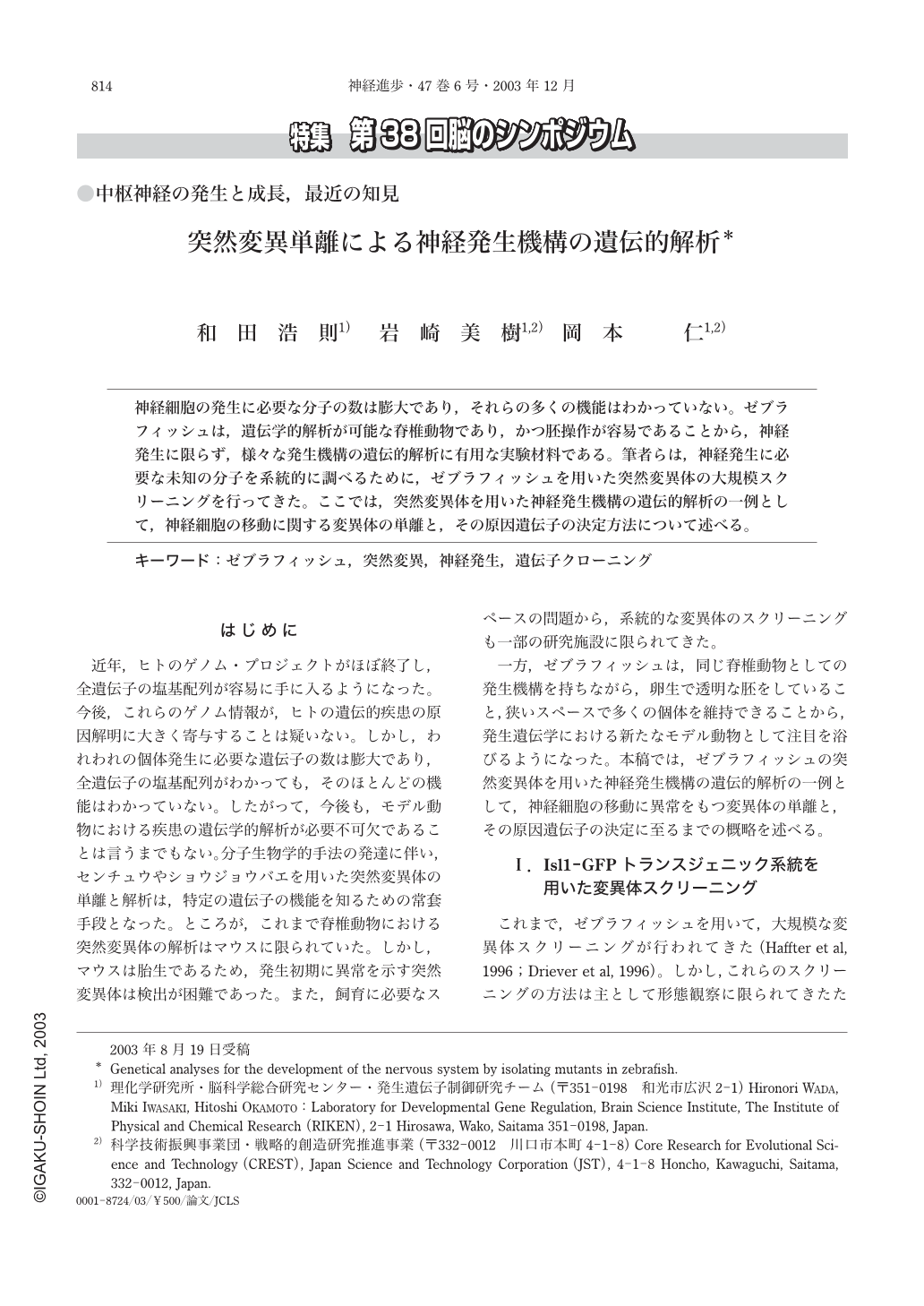Japanese
English
- 有料閲覧
- Abstract 文献概要
- 1ページ目 Look Inside
神経細胞の発生に必要な分子の数は膨大であり,それらの多くの機能はわかっていない。ゼブラフィッシュは,遺伝学的解析が可能な脊椎動物であり,かつ胚操作が容易であることから,神経発生に限らず,様々な発生機構の遺伝的解析に有用な実験材料である。筆者らは,神経発生に必要な未知の分子を系統的に調べるために,ゼブラフィッシュを用いた突然変異体の大規模スクリーニングを行ってきた。ここでは,突然変異体を用いた神経発生機構の遺伝的解析の一例として,神経細胞の移動に関する変異体の単離と,その原因遺伝子の決定方法について述べる。
はじめに
近年,ヒトのゲノム・プロジェクトがほぼ終了し,全遺伝子の塩基配列が容易に手に入るようになった。今後,これらのゲノム情報が,ヒトの遺伝的疾患の原因解明に大きく寄与することは疑いない。しかし,われわれの個体発生に必要な遺伝子の数は膨大であり,全遺伝子の塩基配列がわかっても,そのほとんどの機能はわかっていない。したがって,今後も,モデル動物における疾患の遺伝学的解析が必要不可欠であることは言うまでもない。分子生物学的手法の発達に伴い,センチュウやショウジョウバエを用いた突然変異体の単離と解析は,特定の遺伝子の機能を知るための常套手段となった。ところが,これまで脊椎動物における突然変異体の解析はマウスに限られていた。しかし,マウスは胎生であるため,発生初期に異常を示す突然変異体は検出が困難であった。また,飼育に必要なスペースの問題から,系統的な変異体のスクリーニングも一部の研究施設に限られてきた。
一方,ゼブラフィッシュは,同じ脊椎動物としての発生機構を持ちながら,卵生で透明な胚をしていること,狭いスペースで多くの個体を維持できることから,発生遺伝学における新たなモデル動物として注目を浴びるようになった。本稿では,ゼブラフィッシュの突然変異体を用いた神経発生機構の遺伝的解析の一例として,神経細胞の移動に異常をもつ変異体の単離と,その原因遺伝子の決定に至るまでの概略を述べる。
Although the human and mouse genome projects have recently completed, functions for most of the genes remain unknown. Zebrafish is an excellent model to study functions of genes in the development of the nervous system because of its genetical and embryological accessibility. By taking advantage of this nature, we are now carrying out a large-scale mutagenesis and have been isolated many mutant strains which have defects in development of brain structures. Here, we show the novel mutants in which the migration of the neuronal cells is impaired.
In the zebrafish hindbrain, the facial motor neurons are born in rhombomere 4(r4), and they migrate caudally into rhombomere 6(r6), where they form the facial motor nucleus. We showed that two novel genes, landlocked(llk) and traffic jam(tam), are required for the migration of facial motor neurons. Here, we report our study toward molecular identification of the llk gene by positional cloning strategy.
Firstly, we mapped the llk locus by the bulked segregant analysis(BSA). The llk locus was assigned to the linkage group 7. Secondly,the representational difference analysis(RDA)was carried out to isolate closely linked DNA fragments. In consequence, we obtained a DNA fragment located at 0cM distance from the llk locus. By screening of a PAC library together with the Sanger Institute zebrafish genome database, genomic sequences associated with the RDA fragments were obtained. At this moment, we identified~500 kb region covering the llk locus, and several genes are predicted in this region. To identify the mutation site, further recombinational analyses and isolation of the candidate genes are now under way.

Copyright © 2003, Igaku-Shoin Ltd. All rights reserved.


